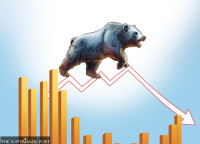Money
Nepse closes year 444.5 points higher
Despite weak macroeconomic indicators, the capital market had a bull run in 2072 BS. The Nepal Stock Exchange (Nepse) closed the last Nepali calendar year 444.5 points higher.
Despite weak macroeconomic indicators, the capital market had a bull run in 2072 BS. The Nepal Stock Exchange (Nepse) closed the last Nepali calendar year 444.5 points higher.
The country last year faced two crises—the April 25 earthquake and Indian trade embargo—that severely affected the economy. But the share market reacted as if everything was okay.
In the period between mid-April 2015 and mid-April 2016, average daily transaction in the secondary market surged to Rs600-700 million from Rs300-400 million.
The market that opened the year at 944.13 points on April 15, 2015, closed at 1,388.63 points on April 12, 2016—the last day of the Nepali calender year. With the rise in
market capitalisation to Rs1496.56 billion from Rs968.92 billion, investors gained a total of Rs527.64 billion over the period.
Stocks analysts attributed the surge to excess liquidity with banks, which resulted in easy availability of cheaper margin loans. Other factors contributing to the rise include the central banks’ directive to banks and financial institutions (BFIs) to hike their paid-up capital, leading to increased investor attraction towards BFI shares hoping for the issuance of right’s and bonus shares.
Also, the full-fledged implementation of demat (paperless) share transaction system since January 15, 2016., which made the share ownership transfer process swifter, boosted investor confidence.
Niraj Giri, spokesperson for the Securities Board of Nepal (Sebon), said the surge in stock market was a result of speculation rather than a market supported by economic fundamentals. “Easy loan availability also helped market rise,” he said.
International Monetary Fund has projected the country’s economic growth rate for 2016 at just 0.5 percent. The government too has projected an economic growth rate of 2 percent for this fiscal year.
Amid speculative investment. Amid speculation driving the market higher, Sebon cautioned investors several times last year over possible risks. After the April 25 earthquake hit the country, the secondary market remained closed for almost a month. Following the catastrophe, the Nepse plunged to the year’s lowest of 837.83 points on May 27. However, the index followed an upward trend and crossed the 1,000-point mark on July 23.
Anjan Raj Poudyal, managing director of Thrive Brokerage House, said the market initially grew as investors considered the stock market as the next best alternative to the realty business. “However, the investors appeared more mature in the successive days,” he said.
According to Poudyal, the regulators’ plan to raise capital requirements for insurance and microfinance company also contributed to the market rise. As a result, the Nepse hit 1,191.92 points on August 19 to break the record of 1,175.38 points of August 31, 2008. The escalating market remained unaffected even when India imposed a trade embargo on Nepal since September 22, 2015. The embargo lasted for more than four months.
Poudyal said the Indian embargo, in fact, helped market grow. “As the real sector was badly affected by the fuel crisis, investors considered the stock market the best alternative,” he said.




 19.12°C Kathmandu
19.12°C Kathmandu












%20(1).jpg&w=300&height=200)
